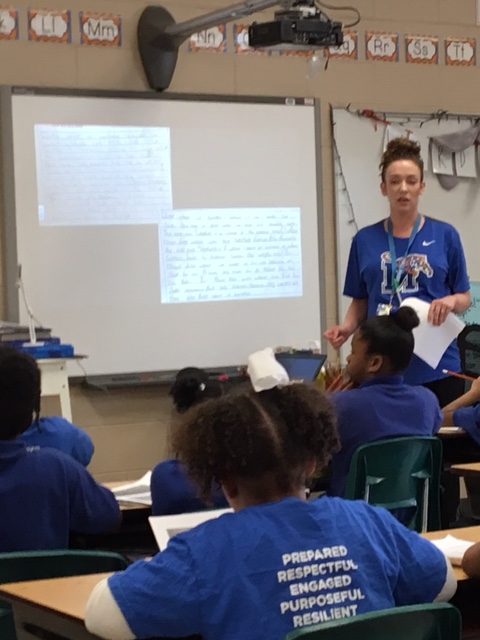04.09.19A Postcard from Cornerstone Prep in Memphis

Darryl Williams and I had the pleasure of visiting two campuses of Memphis’ Cornerstone Prep last Friday. They’re both ASD neighborhood schools–two of the highest performing in the ASD, and not surprisingly I learned a lot from our visit.
The school was warm and inviting for students and adults. In both cases expectations for what happened in the classroom were high but the mood was encouraging, and there was clearly a mentality that embraced growth.
In fact that was the first thing I noticed: I walked into classrooms accompanied by several administrators and still the teachers seemed calm, happy, natural. Most tellingly, several teachers did what I would call ‘high-difficulty dives’–maneuvers that were challenging and not strictly necessary–while being observed.
When an administrator walks into a teacher’s room at some schools the teacher goes into risk-reduction mode: Do what can’t go wrong; call on the kids you know will give you solid answers. But at Cornerstone one teacher Cold Called a student who had been set apart from the group moments before and was scowling in his chair. She did so with warmth and inclusiveness and managed to engage him in her lesson. By the end the scowl had disappeared…it was a beautiful moment- but not strictly necessary- with her bosses in the room she could have ignored him for the time being- goodness knows that interaction could have turned out differently. But she went for it.
Only at a school with a trusting relationship among the adults would a teacher voluntarily take a risk like that in front of the administration–not to mention visitors! But several times we saw teachers avoiding the safe thing and doing the challenging thing- a trend that suggested to Darryl and I the presence of a strong culture of error among the adults. To get better at teaching, there’s no way to avoid challenge and some risk-taking. What does it say about a school if teachers try to hide the difficult part of their work from the organization and instead do what’s easy and safe in front of them? The presumption at Cornerstone seemed to be that the organization would think it was a good thing if teachers did what was hard rather than what was easy if it would make them better in the long run. That to me almost more than anything explains why the school is tops in the ASD.
* * * *
Another takeaway was about voice range, and especially the power of a whisper. Several teachers at Cornerstone Lester in particular used whispers in a way that was positively artful– there were dramatic playful whispers, whispers used to correct minor off-task behavior, suspense building stage whispers–we’re going to find out who won the war of 1812! Teachers used them to connect with and engage students positively in learning. I noticed the power of this most in Ms. Zomer’s room–it was first grade, I believe–she entranced her kiddos over and over by raising her level of excitement than dropping into a stage whisper. The question, ‘Who thinks they can spell ‘wand’?’ for example is not the most exciting question ever asked by a teacher, but when done in a whisper instead of the usual teacher voice it brought out waves of excitement and a dozen raised hands in Ms. Zomer’s class, and it struck me in that being able to use that full dynamic range only works if the classroom is quiet enough to hear the whisper clearly. It, like most relationship building moments, is predicated on order. And Cornerstone had that–bright warm positive and nurturing while always orderly.
* * * *
A final moment from Ms. Caballero’s class, where we saw an impeccably prepared and executed Show Call. Her students had been working on responses to an article on the importance of clean drinking water and she had collected their drafts the day before. The had chosen two very strong examples and copied them. She projected them on the smart board and gave each student a copy. “Which one is spicier she asked,” 9this might have been done in a stage whisper come to think of it) and students wrote their analysis of their peers’ answers for four minutes before they discussed the pieces with a peer. Both were strong answers and the question was which one was best.
Here’s an excerpt from one of them to show you the level of quality:
Dirty water is harmful because it can make you sick. One reason is dirty water can make your stomach hurt. The text says, “Giardiosis is an infection of the digestive system,” which means dirty water can give everybody diarrhea*. Also, according to the text, “Hepatitis A, often caused by viruses in water supplies, leads to tiredness, nausea and weight loss.” This … is why dirty water is so harmful.
Before diving into their study of student writing during PD later that afternoon, Ms. Caballero and a colleague discussed how this moment unfolded. Because it was so clear that quality got you Show Called, both writers felt pride. And the discussion of the strong points of both allowed students to see a path to truly exceptional work. Last of all it stressed the importance of proof reading… the areas for improvement were sometimes things that the writer had raced through.
All in all, we were pretty inspired by how Ms. Caballero and her colleagues used Show Call to build a culture of writing and revision among their scholars
*this was read aloud snicker- and giggle-free, by the way.
